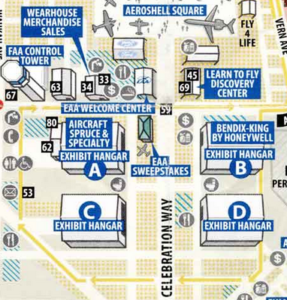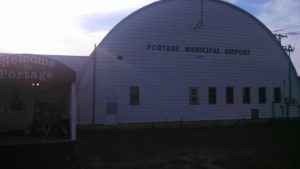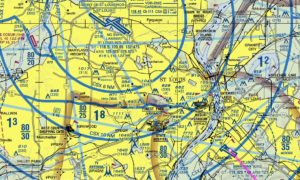Let me start by saying that I am not an expert on Oshkosh nor travel to and from. I have done it and survived to write about it. I have made several long cross country trips in a small airplane. I would like to share with you what I did to get ready for the trip and staying at Oshkosh.
Part 1 PreFlight
 I fly my Comanche 180 from Ocala Florida up to Oshkosh. According to SkyVector the flight is 938.1 nautical miles in length and would take approximately 7 hours and 52 minutes at 120 knots and burn 87.9 gallons of fuel at 10 gph, give or take a few. Realizing that my bladder nor the Comanche’s fuel capacity would carry me that far, I would need to make stops. I like to keep my flight legs under 4 hours, in fact if I can get 2.5 to 3 hour legs all the better. So I added some stops, based on fuel and comfort of my passengers. Thus the route became KOCF->KCTJ->2R2->KOSH Link to the Route on Skyvector. This way I am not over tired and sore from the flight.
I fly my Comanche 180 from Ocala Florida up to Oshkosh. According to SkyVector the flight is 938.1 nautical miles in length and would take approximately 7 hours and 52 minutes at 120 knots and burn 87.9 gallons of fuel at 10 gph, give or take a few. Realizing that my bladder nor the Comanche’s fuel capacity would carry me that far, I would need to make stops. I like to keep my flight legs under 4 hours, in fact if I can get 2.5 to 3 hour legs all the better. So I added some stops, based on fuel and comfort of my passengers. Thus the route became KOCF->KCTJ->2R2->KOSH Link to the Route on Skyvector. This way I am not over tired and sore from the flight.
You may recall from one of my older posts, that I always plan alternates. I selected these primary sites based on distance, fuel price and proximity to other landing options. Also I really want to fly the Chicago skyline along the coast of Lake Michigan. Therefore I planned the route to take us just along the western side of Lake Michigan as we fly to Oshkosh. Keep in mind there is much more to do before blasting off into the sky, the most important of those being to read the Oshkosh NOTAM.
Taking NOTAM
Every year EAA publishes the Oshkosh NOTAM. About a month or so before the event, I request a copy be mailed to me and I download a copy so I can start reading immediately. I read this NOTAM through a couple of times and then make notes of the pertinent facts that most apply to me, and highlight the most important facts for quick reference in flight. As I will be flying VFR I try to focus on those parts of the NOTAM to understand how I get in and out of Airventure safely.
 The most relevant then becomes the Fisk VFR Arrival to OSH section which outlines how to approach, communicate and get sequenced for landing. Some of the important parts I highlighted were as follows.
The most relevant then becomes the Fisk VFR Arrival to OSH section which outlines how to approach, communicate and get sequenced for landing. Some of the important parts I highlighted were as follows.
- Ensure lights are on, and all non-ADS-B equipped aircraft set transponder to Standby within 30 miles of OSH.
- Obtain Arrival ATIS (125.9) no later than 15 miles from Ripon and note arrival runways in use.
- Have NOTAM arrival pages mentioned on ATIS available. Then monitor Fisk Approach (120.7)
- Arrive at Ripon at 90 knots and 1,800’
One additional point, I programmed the RIPON and FISKE intersections into my GPS, but the NOTAM specifically mentions that you must visually navigate over the railroad tracks, which are not in the same place as the intersections. So I had to keep my eyes outside and look for the railroad tracks. Oh and these tracks are not really visible! I figured out that they were hidden by a line of trees and follow the tree line over the tracks from RIPON to FISKE.
Assigned a Runway
Once you arrive at FISKE the controller on the ground will call you out by aircraft type and color. I got “White low wing with lights at the ends of the wings” He then guessed I was a Cherokee. Now as a Comanche driver I do not take offense that he was unable to see that I was a Comanche. I did however correct him and thank him for his efforts that day.
 At this point the arrival controller gave me instructions on which runway and frequency I was supposed to use. On the days I went last year there was a light westerly wind so I was sent to runway 27 and given that tower’s frequency. Now it is very important to listen close at this point. Lots of airplanes are coming into the pattern at the same time, some in front and behind, but also planes lining up for straight in approach. The pace of the controller’s cadence is fast and complicated as planes will be taking off, landing, exiting the runway and going around right underneath. My instructions changed a few times between the first call and the point when I exited the runway.
At this point the arrival controller gave me instructions on which runway and frequency I was supposed to use. On the days I went last year there was a light westerly wind so I was sent to runway 27 and given that tower’s frequency. Now it is very important to listen close at this point. Lots of airplanes are coming into the pattern at the same time, some in front and behind, but also planes lining up for straight in approach. The pace of the controller’s cadence is fast and complicated as planes will be taking off, landing, exiting the runway and going around right underneath. My instructions changed a few times between the first call and the point when I exited the runway.
One last point on landing, is that the controllers want you off the runway and into the grass as soon as possible. My first day I touched down a bit hot and rolled quite a ways before I was able to exit the runway safely, The good news is that the grass is very smooth and the tires on a Comanche are plenty big so exiting was not too troublesome.
Video of Flight from FISKE to Runway 27 and parking.
Parking Pass
Getting to parking is a bit of an adventure. After I got off the runway, I held up a sign for the parking area VAP so the ground marshals could guide me. My Comanche qualifies for vintage parking, so I was directed all the way back down 27 and around the airport to the west side of runway 36 where I was parked about half way down in the vintage section. Very good spot for watching the airshows.
Leaving the Show
 As I had a hotel out at Portage, I commuted in and out. I like camping, but I only go two or three days so it seems a waste to carry all that gear when I can sleep in a comfy hotel bed. After the airshow is done for the day, the airport is once again open for a few hours and I was able to depart. Again the NOTAM came in really handy. I was directed to depart runway 18R. So I had to follow some important procedures:
As I had a hotel out at Portage, I commuted in and out. I like camping, but I only go two or three days so it seems a waste to carry all that gear when I can sleep in a comfy hotel bed. After the airshow is done for the day, the airport is once again open for a few hours and I was able to depart. Again the NOTAM came in really handy. I was directed to depart runway 18R. So I had to follow some important procedures:
- Transponder still in standby until clear of class D.
- Fly heading 180 at or below 1300 MSL until clear of class D airspace.
- Be aware I would overtake and be overtaken by other planes
Then the flight becomes just like any other VFR flight I have done. Nothing else changes. I hope this article gives you some insight into the planning and important tasks to accomplish when flying into Airventure.






























 Another interesting stop was the Cahokia mounds. This is the remnant of a native american city that lasted some 300 years. They build pyramids and had a whole city with walls and even their own version of Stonehenge – but with wooden poles. Here is a link to the museum website: http://www.cahokiamounds.org/
Another interesting stop was the Cahokia mounds. This is the remnant of a native american city that lasted some 300 years. They build pyramids and had a whole city with walls and even their own version of Stonehenge – but with wooden poles. Here is a link to the museum website: http://www.cahokiamounds.org/


 I take a good amount of time in planning my route, which involves activities such as studying the terrain along my chosen path and making note of any distinctive landmarks or features. I also review approach procedures for my landing sites, and mentally note any alternate or emergency landing sites. I often go on YouTube and look for videos from other pilots that are flying routes and landing at the airports I might use. You would be surprised at how much you can glean from watching a video of someone landing at an airport you might use along your route.
I take a good amount of time in planning my route, which involves activities such as studying the terrain along my chosen path and making note of any distinctive landmarks or features. I also review approach procedures for my landing sites, and mentally note any alternate or emergency landing sites. I often go on YouTube and look for videos from other pilots that are flying routes and landing at the airports I might use. You would be surprised at how much you can glean from watching a video of someone landing at an airport you might use along your route.